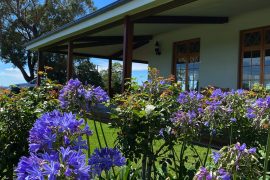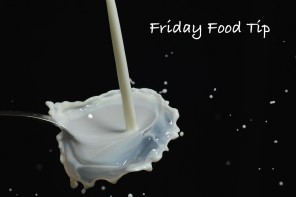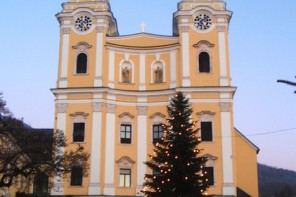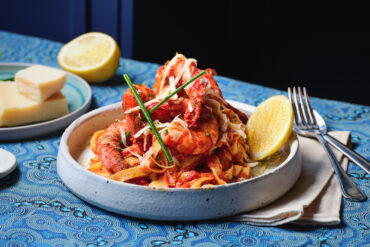Published in Vacations & Travel Summer 2006 edition.
There was one word Australian-born Mary Donaldson had to learn very quickly when it became clear she was going to marry Denmark’s Crown Prince Frederik. It was the Danish word “hygge” which, loosely translated, means “warm and cosy with good food and drink”.
Most people outside of Denmark know little about Danish food, except for the ubiquitous Danish pastry. You certainly won’t have any trouble finding a bakery in Denmark– they’re on every second street corner.
But curiously, the pastries that everyone else in the world knows as Danish are known in Denmarkas wienerbrød, orVienna bread – apparently because the style was perfected by a Danish baker who moved toAustria in the 18th century.
Other popular Danish delicacies include smoked salmon, butter cookies, sausages, cheese, and herring marinated with herbs and spices. And then there is smørrebrød, open sandwiches made with rye bread, found in countless lunch bars throughout the country.
While Danish cuisine relies heavily on fish, meat and potatoes, there’s a rapidly emerging trend to what has been dubbed “new Scandinavian cuisine”. A bit like our own modern Australian cuisine, it takes fresh local produce and infuses it with outside influences, though in Denmark it is more likely to be a French influence rather than the Asian influence that it often is here.
One chef who has been praised by critics for his innovative Scandinavian cuisine is Paul Cunningham, of The Paul restaurant in Tivoli. The Paul opened in 2003 and won a Michelin star the following year – the first in the history of Copenhagen’s beloved amusement park.
Tivoli has been entertaining people since 1843 and has almost 30 places to eat, one of them, Divan 2, operating since the beginning.
One of Copenhagen’s most exclusive restaurants is Kommandanten, where the food is served on Royal Copenhagen porcelain. It is the city’s only restaurant with two Michelin stars.
There’s a French-Danish menu at Jacobsen, a restaurant in Klampenborg, north ofCopenhagen, decorated with the furniture and tableware of famous Danish designer Arne Jacobsen (1902-1971). He designed Copenhagen’s Radisson SAS Royal Hotel in 1960 and it still bears his influence.
His famous Swan and Egg chairs were originally designed for the hotel lobby. On the top floor of the Radisson SAS, there is a modern Italian restaurant, Alberto K, with spectacular views of the city.
There are still plenty of traditional cosy restaurants and inns throughout the country.Copenhagen’s Nytorv Restaurant & Café is quintessential Denmarkwith a cosy ambience.
In a quaint old building overlooking a cobbled square, it offers hearty, traditional fare like roast pork and potatoes, but even here, where there is some concession to tourist budgets, the meal is expensive by Australian standards.
Unless you have a fat wallet, don’t even think about wine. It costs around $A10 for a glass of house wine, usually a terrible French red that looks and tastes like coloured water.
While Australian wine is making some inroads into the Danish market, many wine lists are focused squarely on French wine, fine at the top end of the market but not so palatable at the bottom end. Perhaps Princess Mary might pave the way for more Aussie wine on Danish menus.
Dining out in Denmark is expensive but there are ways to ease the pain. The Danish version of fast food is the hotdog, and you’ll find sausage stands everywhere, serving sausages on bread with pickles and other accompaniments.
You might also enjoy some freshly smoked herring by the quayside. It would be hard to find a Danish spread that doesn’t include herring – marinated, in tomato sauce or pickled. In days gone by, family recipes for pickled herring were passed down through the generations.
It seems there is no limit to what you can do with herring. Some chefs are doing dill herring, garlic herring and even passionfruit herring. Surrounded by theNorth Sea, the Danes naturally like their fish.
Another good option for budget-minded travellers is to assemble a meal from some of the terrific ingredients available in the Magasin department stores. Magasin also does a great takeaway box, using your choice of cold meats, salad and dressing.
The Magasin du Nord department store can be found at one end of Stroget,Copenhagen’s delightful pedestrian mall. Just around the corner, overlooking the Royal Theatre, is Café a Porta, one of the city’s oldest cafés. Writer Hans Christian Andersen once lived just above the café and was a frequent guest.
For most of his life, however, he lived on Nyhavn Canal, first at No 20, later at No 67 and finally at No 18. Tourists mingle with locals in this picturesque harbour street which today abounds with open-air cafes, restaurants and bars.
One ofCopenhagen’s most beautiful coffee shops was already in existence in the 1870s when Hans Christian Andersen lived in the city. Although there is no evidence that he actually visited La Glace, he is known to have had a sweet tooth. In a letter to a friend in 1832, he wrote: “I have to drink gruel and I only get a little jam in it, and still my doctor calls me a sweet tooth.”
To celebrate the bicentennial of Hans Christian Andersen’s 1805 birth, the owner of La Glace, confectioner Marianne Stagetorn Kolos, created 13 cakes inspired by his fairytales. She produced a beautiful book with recipes for the cakes, interspersed with the stories that inspired them.
Another talented confectioner, Mette Blomsterberg, runs the café at Ny Carlsberg Glyptotek, a museum of art and antiquities. Celebrating its centenary in 2006, the Glyptotek has a beautiful palm court where you can rest and enjoy the delicious cakes and pastries. They don’t come cheap: about $A5 for a rum ball and $A10 for a small slice of pecan pie.
One way that visitors can experience the Danish concept of “hygge” at first hand is to sign up for a home dinner. These can be arranged through two agencies: Dine with the Danes or Meet the Danes. They try to match visitors with the hosts, who serve a two-course dinner with drinks, for a set price.
The best way to experience fresh Danish produce is to get out into the countryside, where farms and orchards often sell fresh fruit and vegetables from roadside stalls. Many small independent dairies are making gourmet cheeses, and there are farmshops where you can buy everything from elderberry cordial to honey and homegrown berries.
The train journey from Copenhagen to Odense, birthplace of Hans Christian Andersen, takes just one and a half hours.Odenseis on the island of Fyn, described by Hans Christian Andersen as the “garden of Denmark”. The charming old quarter of Odense has an excellent market on Wednesdays and Saturdays, where farmers come to sell their wares.
On the outskirts ofOdense, Den Fynske Landsby is an open-air museum that recreates a village from Hans Christian Andersen’s time (1805-1875). Amongst the half-timbered buildings are gardens, fruit trees and cultivated fields with cows, goats and geese. Farmers go about their chores, women bake on the old wood stoves, and you can have a go at making apple juice using old-fashioned implements.Fynhas a great tradition of apple drinks and there is still a cider plant on the island.
The gift shop at Den Fynske Landsby sells an excellent book called A Guide to Funen’s Temptations, which points visitors in the direction of artisan food and drink producers. One of them is the Refsvindinge Brewery in the eastern part of the island, where the Rasmussen family have been making beer since 1885.
Their boutique beers are highly acclaimed and they do an unusual and surprisingly appealing strawberry beer. Hans Christian Andersen waxed lyrical about the strawberries onFyn. After one visit to Lykkesholm Slot, a castle not far from the brewery, he wrote about the exquisite strawberries and the cream that was “so thick a spoon could stand up in it”.
Around 120 Danish farms invite visitors to do a farmstay, and this is a great way of experiencing everyday life in the country. There are also some terrific regional inns, such as Falsled Kro, a 14-room inn with a restaurant that breeds its own quail, grows its own raspberries and uses locally caught salmon, trout and turbot.
One restaurant that deserves to be visited for the ambience alone is Den Gaemle Kro inOdense. Dating from 1683, it is extraordinarily quaint and cosy with all sorts of knick-knacks around the walls and tables, and a seasonal menu drawing on the local specialities.
Danish chefs move heaven and earth to lay their hands on new-season potatoes and other produce such as asparagus and chanterelles, a wild mushroom harvested from mid-summer to mid-October.
Denmark’s Prince Consort, Prince Henrik, is pictured collecting mushrooms in a book called Fit for a Royal Dane that I bought during my visit. The French-born prince is apparently quite a gourmand and the book features his recipes and writings on food and wine. It also has a picture of him and his son, Crown Prince Frederik, hunting venison.
If the gossip magazines are anything to go by, Frederik and Mary’s new baby has already been given a taste of the good life – one Australian magazine reported that it is traditional in Prince Henrik’s family for the grandfather to smear a newborn baby’s lips with garlic and place a few drops of red wine in the baby’s mouth.
Fact file:
Getting there:
Scandinavian Airlines (SAS) is a natural choice to Scandinavia and Northern Europe with the fastest daily connection via Bangkok, Singapore or Tokyo direct to Copenhagen in as little as 22 hours. It flies three times a week from Sydney and Melbourne toShanghai, and six times a week between Shanghai and Copenhagen. Inquiries: 1300 727 707 or www.scandinavian.net
Getting around:
Bentours can organise package tours toDenmark, or arrange independent travel. Its Scandinavia & Russia brochure lists transport and accommodation options, escorted and non-escorted tours, and cruises. Inquiries: +61 (2) 9241 1353 or www.bentours.com.au
Hans Christian Andersen Tours offers a three-night gourmet tour of Fyn. Inquiries: +45 (63) 618 088 or www.hcatours.com
Tip: Unlike most of Europe, Denmark has not adopted the Euro though many businesses will accept it.
Further information:
Travel information: www.visitdenmark.com
Dine with the Danes: +45 (26) 853 961 or www.dinewiththedanes.dk
Meet the Danes: +45 (33) 464 646 or www.meetthedanes.dk
Danish farmstays: +45 (86) 373 900 or www.bondegaardsferie.dk
© Christine Salins




